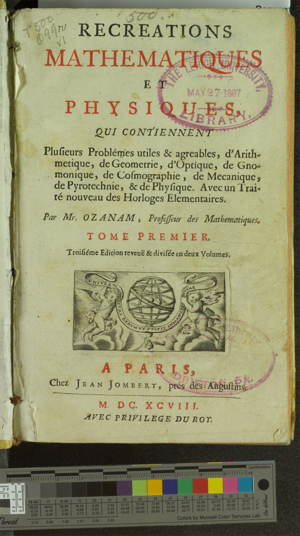Jacques Ozanam (nonfiction)
Jacques Ozanam (16 June 1640, in Sainte-Olive, Ain – 3 April 1718, in Paris) was a French mathematician.
Biography
Jacques Ozanam was born in Sainte-Olive, Ain, France.
In 1670, he published trigonometric and logarithmic tables more accurate than the existing ones of Adrien Ulacq, Bartholomaeus Pitiscus, and Henry Briggs. An act of kindness in lending money to two strangers brought him to the attention of M. d'Aguesseau, father of the chancellor, and he secured an invitation to settle in Paris. There he enjoyed prosperity and contentment for many years. He married, had a large family, and derived an ample income from teaching mathematics to private pupils, chiefly foreigners.
His mathematical publications were numerous and well received. Récréations (published 1694) was later translated into English and is well known today. He was elected a member of the Académie des Sciences in 1701. The death of his wife plunged him into deep sorrow, and the loss of his foreign pupils through the War of the Spanish Succession reduced him to poverty. He died in Paris on April 3, 1718 (frequently cited as 1717 because of an error in "éloge de Fontenelle").
Riddle's description of Ozanam's character:
He was of a mild and cheerful temper, generous to the extent of his means, and of an inventive genius; and his conduct after marriage was irreproachable. He was devout, but averse to disputations about points of faith. On this subject he used to say, "It is the business of the Sorbonne to discuss, of the Pope to decide, and of a mathematician to go straight to heaven in a perpendicular line."
Ozanam was honored more abroad than at home. He was devout, charitable, courageous, and of simple faith. As a young man he had overcome a passion for gambling. He was wont to say that it was for the doctors of the Sorbonne to dispute, for the pope to decide, and for a mathematician to go to heaven in a perpendicular line.
He also taught Abraham de Moivre.
Selected works
- Traité de la construction des equations pour la solution des problemes indeterminez, 1687
- Table des sinus, tangentes, et sécantes (1670)
- Methode générale pour tracer des cadrans (1673)
- Geometrie pratique (1684)
- Traité des lignes du premier genre (1687)
- De l'usage du compas (1688)
- Dictionnaire mathématique (1691)
- Cours de mathématiques (Paris, 1693, 5 vols, tr. into English, London, 1712)
- Traité de la fortification (Paris, 1694)
- Récréations mathématiques et physiques (1694, 2 vols, revised by Montucla in 1778, 4 vols)
- Nouvelle Trigonométrie (1698)
- Méthode facile pour arpenter (1699)
- Nouveaux Éléments d'Algèbre (1702)
- La Géographie et Cosmographie (1711)
- La Perspective (1711).
See also:
- VIII. Formulas for Generating Pythagorean Triples
References
- Bernard Le Bovier de Fontenelle (1790) Eloge de Ozanam, Oeuvres de Fontenelle, Tome 6, p 506, link from Internet Archive.
Sources
- Ozanam, Jacques, (1844). Science and Natural Philosophy: Dr. Hutton’s Translation of Montucla’s edition of Ozanam, revised by * Edward Riddle, Thomas Tegg, London. Read online- Cornell University
External links
- Wikiquote has quotations related to: Jacques Ozanam
- O'Connor, John J.; Robertson, Edmund F., "Jacques Ozanam", MacTutor History of Mathematics archive, University of St Andrews.
In the News
Fiction cross-reference
Nonfiction cross-reference
External links
- Jacques Ozanam @ Wikipedia
